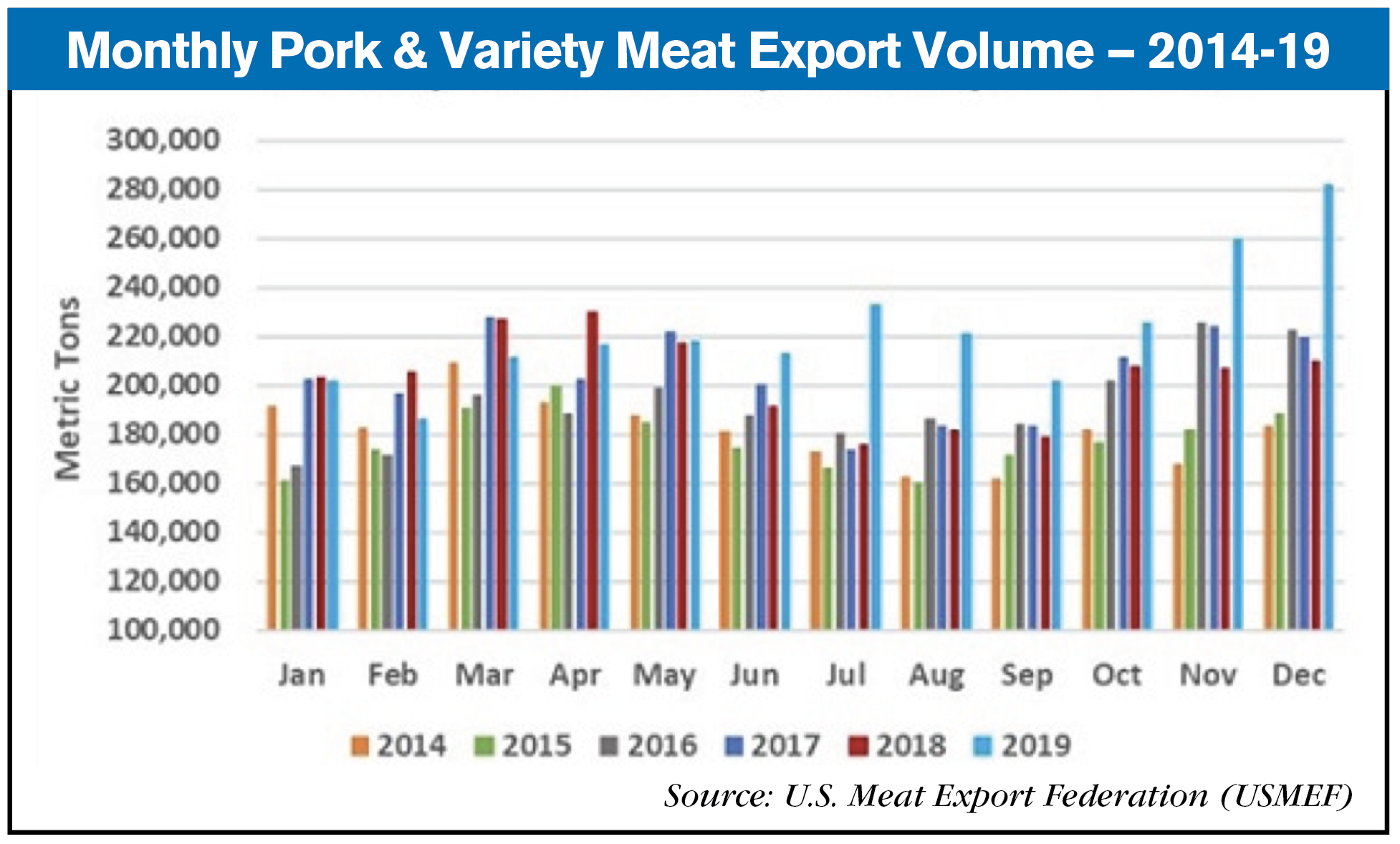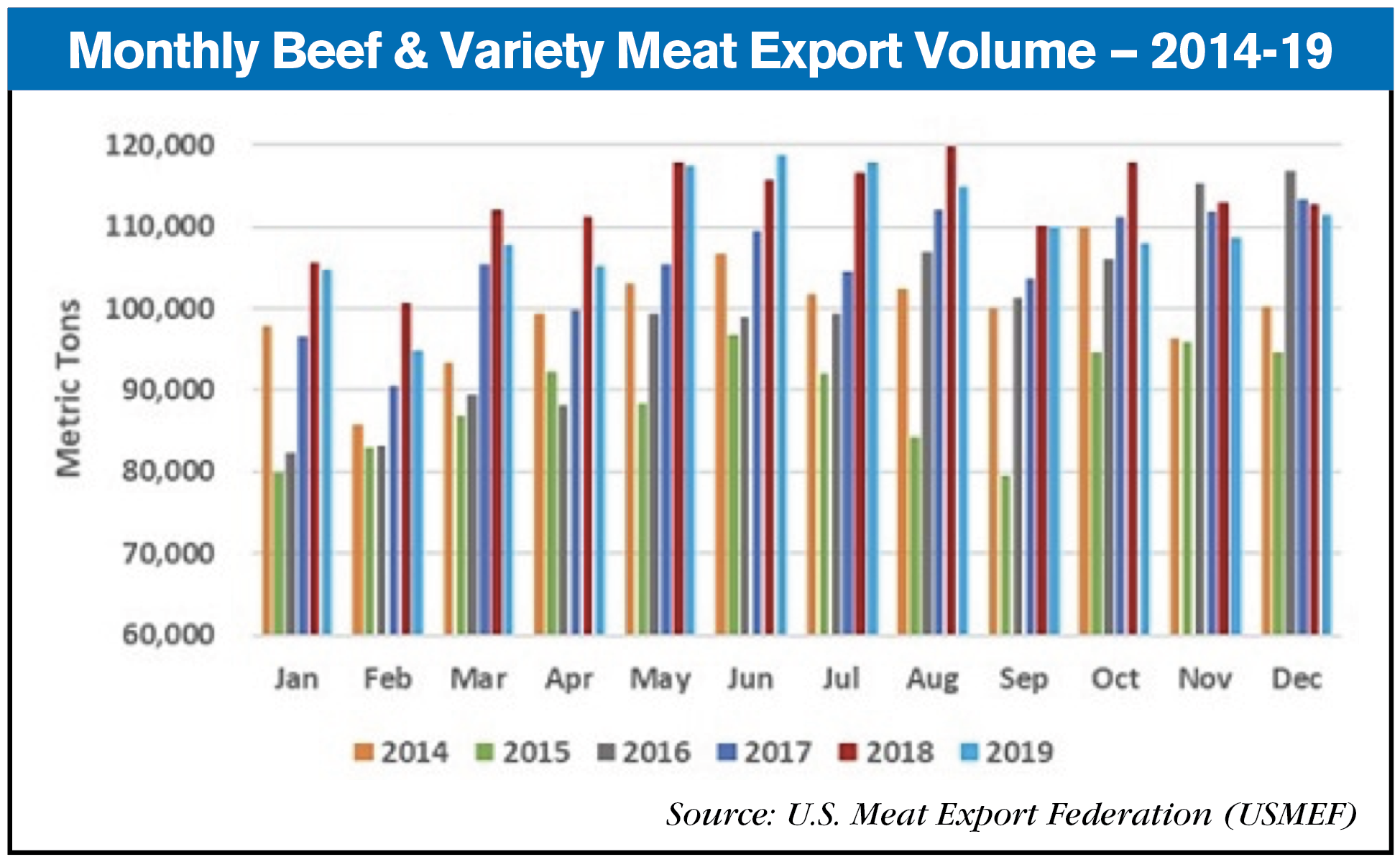According to a report from the U.S. Meat Export Federation, pork exports rose to 282,145 metric tons (311,011 U.S. tons) in December, up 34% year-over-year and surpassing the previous high (set in November 2019) by 9%. Export value was $760 million, up a remarkable 44% from a year ago and breaking the previous record (also from November 2019) by 7%. These results pushed 2019 exports 10% above the previous year in volume, 2.7 million metric tons (2.9 million U.S. tons), and 9% higher in value ($7 billion), breaking previous records for both volume at 2.45 million metric tons (2.7 million U.S. tons in 2017) and value at $6.7 billion in 2014.

December beef exports totaled 111,315 metric tons (122,704 U.S. tons), down 1% from a year ago, valued at $682 million (down 3%). 2019 exports totaled 1.3 million metric tons (1.5 million U.S. tons), 2.5% below the previous year's record volume. After increasing by more than $1 billion in 2018, beef export value eased by 3% to $8.1 billion.

December Pork Demand Rises in China/Hong Kong, Mexico
Following a record performance in November, China/Hong Kong's demand for U.S. pork climbed in December to 110,876 metric tons (122,220 U.S. tons), more than quadruple the year-ago volume, while value was nearly six times higher at $274.9 million. For 2019, pork exports to China/Hong Kong were up 89% to 665,665 metric tons (733,770 U.S. tons), valued at $1.5 billion (up 71%). China/Hong Kong's pork imports from all suppliers in 2019 reached a record 3.5 million metric tons (3.8 million U.S. tons), up 40% year-over-year, and accelerated into December after China's hog prices peaked in November.
"Despite retaliatory duties and the other barriers U.S. pork faces in China, exports to the China/Hong Kong region closed 2019 with tremendous momentum," said Dan Halstrom, USMEF president and CEO. "We look forward to continued success in 2020, especially if U.S.-China trade relations continue to trend in a positive direction. The coronavirus situation is certainly concerning and disruptive, but it hasn't dampened our enthusiasm for the potential this market holds for U.S. red meat."
Pork exports to Mexico also closed 2019 on a high note as December volume reached 66,181 metric tons (72,952 U.S. tons), up 10% from a year ago, and export value surged 46% to $137.6 million, the highest in two years. Saddled by Mexico's retaliatory duties for the first five months of the year, 2019 exports to Mexico were down 9% from a year ago in volume at 708,133 metric tons (780,583 U.S. tons) but recovered to finish just 2% lower in value at $1.3 billion.
December pork exports to leading value market Japan trailed the previous year by 3% in volume at 29,323 metric tons (32,323 U.S. tons), but value increased 3% to $121.6 million. Full-year exports to Japan were down 6% from a year ago in both volume at 369,891 metric tons (407,735 U.S. tons) and value at $1.5 billion. Much of this decline was ground seasoned pork, which fell by $86 million due to a wide tariff rate disadvantage compared to European and Canadian product. Beginning Jan. 1, Japan's tariff rates on U.S. pork and pork products were lowered to match those imposed on major competitors, with the rate for U.S. ground seasoned pork falling from 20 to 13.3%.
New Beef Export Records for Korea and Taiwan
The decline in U.S. beef exports from the record levels of 2018 was partially attributable to lower shipments to Japan, which were down 6% in both volume at 311,146 metric tons (342,979 U.S. tons) and value at $2 billion. Similar to pork, Japan's tariff rates for U.S. beef were lowered on Jan. 1 to match those of major competitors, with rate for U.S. beef muscle cuts dropping from 38.5% to 26.6%. Another tariff rate cut will come April 1, when the Japanese fiscal year begins. December exports to Japan were slightly above year-ago levels in both volume at 24,056 metric tons (25,414 U.S. tons) and value at $144.6 million.
"It was gratifying to see beef exports to Japan perform so well in December, given that the first tariff rate cut was pending and set to take effect Jan. 1," Halstrom observed. "Buyers in Japan have been waiting a very long time for tariff relief and have already responded enthusiastically. We look forward to solid growth in 2020 and beyond."
South Korea made a strong push to become the leading value market for U.S. beef in 2019, finishing a close second to Japan at a record $1.8 billion (up 5% from a year ago). Korea was also the second largest volume market for U.S. beef at 255,758 metric tons (281,924 U.S. tons), up 7%, also a new record. The U.S. captured a larger share of Korea's chilled beef imports in 2019 at 62%, up from 58% the previous year. U.S. beef accounted for 51.5% of Korea's total beef and beef variety meat imports and more than one-third of Korea's total beef consumption.
"U.S. beef is achieving remarkable success in Korea's traditional retail and foodservice sectors and is well-positioned to capitalize on growth in e-commerce, the institutional sector and other emerging sales channels," Halstrom said. "As U.S. beef moves steadily toward duty-free status in Korea, it becomes accessible and affordable for a wider range of customers whose appetite for U.S. beef continues to grow. We are seeing many new menu concepts in this dynamic market and continued excitement about U.S. beef."
Beef exports to Taiwan were record-large for the fourth consecutive year in 2019, climbing 6% from a year ago in volume at 63,538 metric tons (70,039 U.S. tons) and 3% in value at $567.1 million. This growth is also driven by success at foodservice and retail as Taiwan continues to embrace alternative cuts and U.S. beef is underpinning overall consumption growth. The United States dominates Taiwan's chilled beef market, capturing approximately 75% of its chilled imports, the highest share of any Asian destination.



![[Technology Corner] What are the Top 5 Applications in Autonomy Right Now?](https://www.agequipmentintelligence.com/ext/resources/2024/11/08/What-are-the-Top-5-Applications-in-Autonomy-Right-Now-.png?height=290&t=1731094940&width=400)
Post a comment
Report Abusive Comment